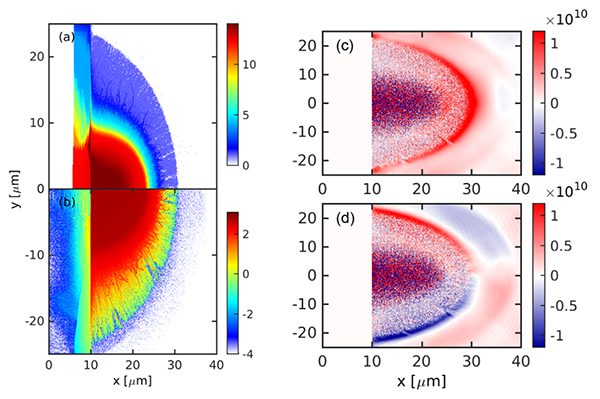The transport of high-current relativistic electron beams driven by ultraintense laser interactions with plasmas is relevant to many applications of high energy density physics, particularly in areas of the fast ignition scheme for inertial confinement fusion, laser-driven ion acceleration and production of ultrashort radiation sources. A target can be ionized by relativistic electrons both through field ionization and collisional ionization, inducing nonlinear and collective effects that can feed back to the transport of relativistic electrons. It is important to comprehensively investigate the transport process of relativistic electrons in such a target, especially in insulators that are without free electrons initially.
In such targets, the transport of relativistic electrons can be inhibited by charge separation fields until a cold return current is generated or the electrons from ionization neutralize space charge fields. One-dimensional theoretical analysis of high-current relativistic electron beam interactions with the insulator showed that the ionization process can be separated into four regions, i.e., a charge accumulation region, a field ionization region, a current and charge neutralization region, and a collisional ionization region. It is observed that an ionization wave propagates with a velocity much slower than the speed of the light during ultraintense laser interactions with dielectric targets. However, the previous studies were mainly limited to 1D analysis or numerical simulations. To comprehensively understand the ionization process in the targets, detailed 2D simulations are required.
The work presented by Dr. Xiaohu Yang from National University of Defense Technology in High Power Laser Science and Engineering, Volume 8, Issue 1, 2020 (X. H. Yang, C. Ren, H. Xu, Y. Y. Ma, F. Q. Shao. Transport of ultraintense laser-driven relativistic electrons in dielectric targets[J]. High Power Laser Science and Engineering, 2020, 8(1): 010000e2) shows ultraintense laser-driven relativistic electron transport in a dielectric silicon target using particle-in-cell simulations including the field and collisional ionization processes. In addition to the intense sheath fields (close to the threshold electric field of field ionization), a widely spread ‘fountain’ electric field occurs ahead due to the collective effect of free electrons and ions, whose magnitude is much less than that of the former and cannot induce ionization. The velocity of the ionization wave increases with laser intensity but is much less than the speed of light and also that from the 1D theoretical analysis, indicating that 2D3V numerical simulations are better to describe the relativistic electron transport in dielectric targets. Two-stream instability (TSI) behind the ionization front arises when the relativistic electron current is sufficiently high.
Prof. Yanyun Ma from National University of Defense Technology believes that the results are helpful for applications related to laser-driven relativistic electron transport in dielectric targets such as fast ignition and laser-driven ion acceleration.

(a) Distributions of average ionization degree, (b) log10 of electron density, (c) the longitudinal electrostatic field, and (d) the transverse electrostatic field, respectively. The electron density is in units of nc. The magnetic field and electric field are in units of T and V/m, respectively.


